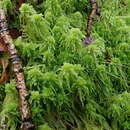Comprehensive Description
provided by North American Flora
Sphagnum quinquefarium (Lindb.) Warnst
Hedwigia 25 : 222. 1886.
Sphagnum aculifolium quinquefarium Lindb.; Braithw. Sphag. 71. 1880. Sphagnum Barllellianum Wamst. in Engler, Pflanzenreich Sphag. 105. 1911.
Plants fairly robust, not infrequently tall, light-green or yellowish or more or less tinged ■with rosy-red. Wood-cylinder greenish-yeUow; cortical cells of the stem in 2-4 layers, large, thin-walled, without fibrils, the outer cells quadrilateral to irregularly pentagonal or hexagonal, sometimes as wide as long, rarely with occasional pores: stem-leaves small, triangular to lingulate-triangular, commonly as wide as long, concave, involute at the toothed apex, the border strong, at the base occupying nearly the whole breadth of the leaf, the walls of its cells pitted; hyaline cells rhomboidal, 3-4 times as long as wide in the apical part, narrower below and at the sides, mostly without fibrils, in the apical part of the leaf often divided, the membrane on the inner surface resorbed in large membrane-gaps, on the outer surface with small gaps in a few cells of the immediate apex, otherwise entire, often with longitudinal membranepleats: branches in fascicles of 5, generally at least 3 spreading, their cortical cells in a single layer, the retort-cells well developed with conspicuous necks, often a second retort-cell above the first: branch-leaves imbricate or generally loosely spreading in 5 ranks, small, lanceolate, slightly involute near the toothed apex, the border entire, of 2-3 rows of narrow cells; hyaline cells fibrillose, narrowly rhomboidal, 8-12 times as long as wide near the base, shorter above to 4-5 times, on the inner surface with small pores in the ends of the cells, in the lower sideregions with large ringless pores, up to 4-5 per cell, on the outer surface with rather small ringed elliptic pores near the commissures, increasing gradually in size toward the base, 3-8 per cell: chlorophyl-cells triangular in section with the base exposed on the inner surface; hyaline cells very slightly if at all convex on the inner surface except in the basal part of the leaf, decidedly convex on the outer surface, one third to one half of the diameter of the cell.
Commonly monoicous. Antheridia in catkins on spreading branches; antheridial leaves reddish, broader in proportion to length than the normal branch-leaves, abruptly involute at the apex, fibrils lacking or rudimentary in the hyaline cells of the basal one fourth to one third. Fruiting branches erect, short; perichaetial leaves lingulate-ovate, abruptly involute at the apex, with both kinds of cells in the upper middle portion, the hyaline cells rhomboidal, often once or several times divided, without fibrils or pores: capsule brown: spores yellow, about 20 M in diameter, slightly granular-roughened.
Type locality: Europe.
Distribution: Newfoundland to Georgia; also in Europe and Asia.
- bibliographic citation
- Albert LeRoy Andrews, Elizabeth Gertrude Britton, Julia Titus Emerson. 1961. SPHAGNALES-BRYALES; SPHAGNACEAE; ANDREAEACEAE, ARCHIDIACEAE, BRUCHIACEAE, DITRICHACEAE, BRYOXIPHIACEAE, SELIGERIACEAE. North American flora. vol 15(1). New York Botanical Garden, New York, NY

